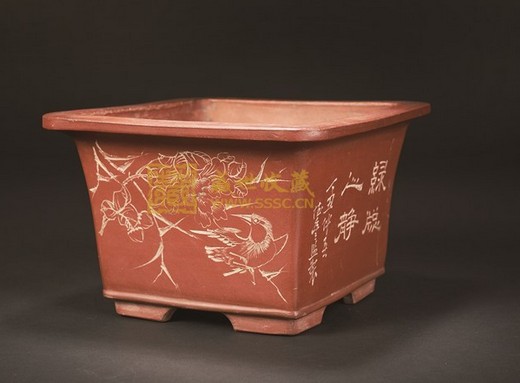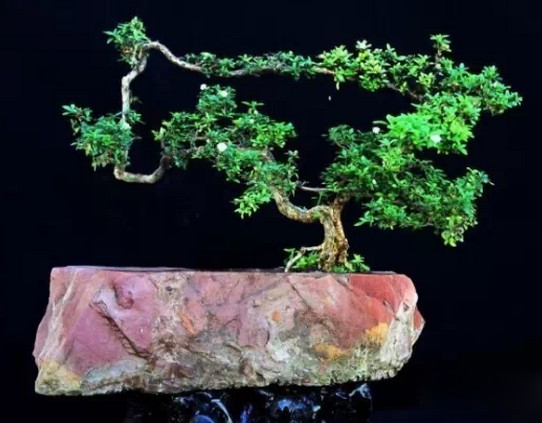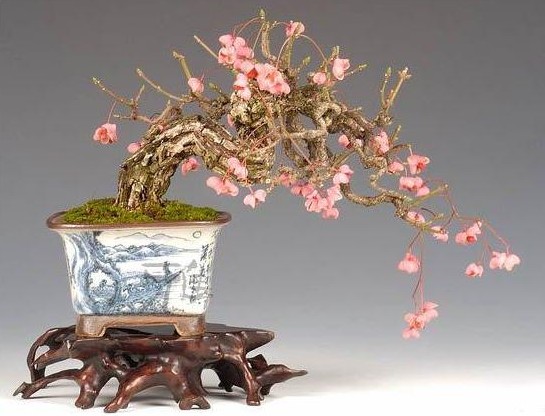Types and principles of pots for bonsai
There are mainly two kinds of bonsai pots: pile landscape basin and landscape basin. There are drainage holes at the bottom of the pile view basin, while there are no drainage holes at the bottom of the landscape basin. There are many styles of pots. According to the different materials of bonsai pots, they can be divided into the following:

1. Purple sand basin: mainly produced in Yixing, Jiangsu Province and other places. The texture is exquisite and tough, the air permeability is good, the style is simple. At present, there are mainly round, square, octagonal and various image forms and other shapes. It can be used not only for pile scenery production, but also for landscape bonsai production.
2. Glazed pottery basin: mainly produced in Shiwan, Guangdong. It has loose texture, good air permeability, simple and elegant style, but dark color, so it is rarely used in landscape bonsai.
3. Porcelain basin: produced in Jingdezhen, Jiangxi, Tangshan, Hebei and Boshan, Shandong. Delicate, hard, gorgeous, but poor air permeability. It is generally used as a set basin or landscape bonsai basin.
4. Stone basin: produced in Dali, Yunnan and Qingdao, Shandong. It is made of natural stone, such as white marble, marble or granite. It is appropriate to make landscape shallow basin or hanging wall bonsai.
5. Cement basin: average output in all places. With white cement as the main raw material, it is characterized by low price, solid and durable. Mostly used for large-scale landscape bonsai.
6. Mud basin: average production in all places. It is characterized by rough and good air permeability. Therefore, it is suitable for pre-use pots, such as tree billets.
7. Bamboo and wood pots: production in Jiangxi and other places. Processed with bamboo and wood as raw materials, it is simple and simple in style. The common ones are bamboo pots, tree tube pots and plate pots. It is often used in the production of pile scenery or wall bonsai.
8. Plastic basin: made of plastic, with many kinds and colors. Characterized by gorgeous, airtight, easy to aging, but cheap, can be made into a variety of shapes, so it is more popular.
9. Copper basins: cast with copper. It's more common in Japan.
How do I use the bonsai?
First, the colors should be coordinated.
The colors of the basin and the scenery should be contrasted to a certain extent in order to reconcile each other. In general, the color of the basin is simple and elegant, which can reflect the role of foil and prevent the guests from taking the lead. Bonsai landscapes usually use white pots, but be careful not to be the same color as the rocks. Bonsai trees should be selected according to the color of the trunk, flowers and fruits should be matched with glazed pottery pots, pines and cypresses should be matched with purple sand pottery pots.
Second, the style should match.
The style of the basin should be consistent with the content of the scene in style. The posture of the trees is Qiu and meandering, the outline of the basin should be mainly curved lines, such as round, oval, etc.; the posture of trees is vigorous and straight, then the lines of the basin should be straight, such as diamond, square and so on. It is appropriate to use a short foot basin for trees with a straight shape, and a high foot basin for trees that are horizontal and elegant. Landscape bonsai generally use a rectangular or oval bottom basin, axe split stone for mountain view, can use a narrow basin; sand accumulation stone for mountain landscape, it is appropriate to use a wider basin; high-distance mountain view, it is appropriate to use a narrower basin; Pingyuan mountain view, it is appropriate to use a wider basin.
Third, the size should be wide.
The size of the basin should be adapted to the matching scene, not even too big or too small. Using the basin too large and storing too much water will not only make the basin appear empty, but also easily lead to the excessive growth of plants, affect the shape, and even cause the death of rotten roots; if the basin is too small, it will make the bonsai appear top-heavy, lack of stability, and insufficient supply of water and nutrients, affecting the growth of plants in the basin. General sturdy trees, the mouth of the basin must not be less than the range of the crown; co-planting basin, it is appropriate to be slightly larger, in order to show a certain space. When using a shallow basin, the mouth of the basin should be larger during the day; when using a deep basin, the mouth of the basin should be smaller. Bonsai bonsai should not be large, otherwise it will make the mountain look small and not majestic, but it should not be too small, too small will make the scenery bloated.
Fourth, the depth should be appropriate.
Bonsai trees with pots too deep will make the trees in the basin appear low, but the trunk trees with pots are too shallow, which will give people a sense of instability and difficult to plant. The bottom basin for landscape bonsai should be very shallow to show the height of the mountain peak, the twists and turns of the foot of the mountain stream, and the scenery such as boats and bridges in the water, which will be covered if the basin is too deep.
Fifth, the texture should be suitable.
Purple sand pottery basin is suitable for pine and cypress bonsai, and glazed pottery basin is generally used for miscellaneous wood. Miniature bonsai should use glaze basin or pottery basin; extra-large available cement basin; landscape bonsai should use stone chiseling basin, followed by glaze pottery basin; flood and drought bonsai should use purple sand pottery basin or stone chisel basin.
Time: 2019-05-23 Click:
- Prev

Bonsai planted in Stone-- the Unity of Natural Beauty and artistic Beauty
Bonsai planted in stone is a combination of trees and stones. The graceful posture of the tree with the help of various vivid shapes of the rock, the two combine into one to produce a sense of beauty, which is the unity of natural beauty and artistic beauty. This kind of beauty is the ideal beauty of mankind.
- Next

The coexistence of traditional bonsai and folk art bonsai
The author of "Records of the sick Plum Museum" called the excessive plum pile as the diseased plum, and tied it up and reborn it. Although this is not the author's original intention, from one side, we can also see that what the literati of all ages advocated is the natural bonsai with strong cultural and artistic atmosphere. The Ming and Qing dynasties are the era of high development of bonsai in China.
Related
- Fuxing push coffee new agricultural production and marketing class: lack of small-scale processing plants
- Jujube rice field leisure farm deep ploughing Yilan for five years to create a space for organic food and play
- Nongyu Farm-A trial of organic papaya for brave women with advanced technology
- Four points for attention in the prevention and control of diseases and insect pests of edible fungi
- How to add nutrient solution to Edible Fungi
- Is there any good way to control edible fungus mites?
- Open Inoculation Technology of Edible Fungi
- Is there any clever way to use fertilizer for edible fungus in winter?
- What agents are used to kill the pathogens of edible fungi in the mushroom shed?
- Rapid drying of Edible Fungi

